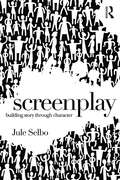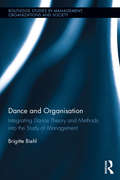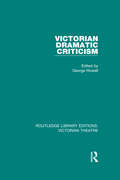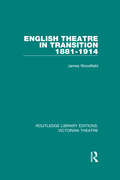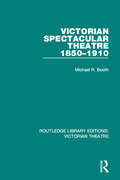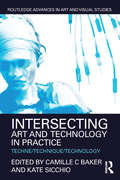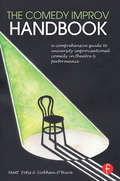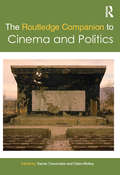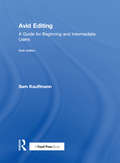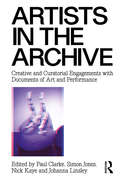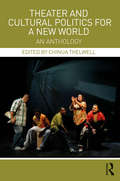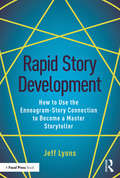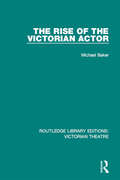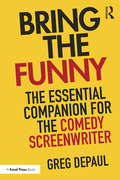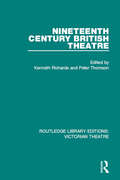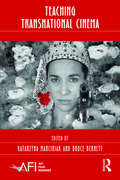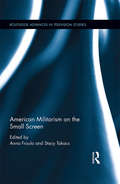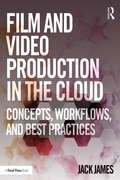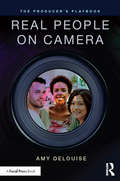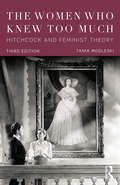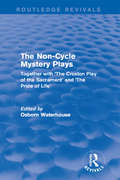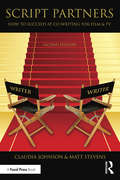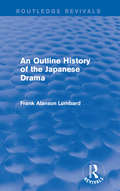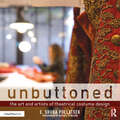- Table View
- List View
Screenplay: Building Story Through Character
by Jule SelboScreenplay: Building Story Through Character is designed to help screenwriters turn simple or intricate ideas into exciting, multidimensional film narratives with fully-realized characters. Based on Jule Selbo’s unique 11-step structure for building story through characters, the book teaches budding screenwriters the skills to focus and shape their ideas, turning them into stories filled with character development, strong plot elements based on obstacles and conflicts, and multifaceted emotional arcs. Using examples and analysis from classic and contemporary films across a range of genres, from The Godfather to Guardians of the Galaxy, Selbo’s Screenplay takes students inside the scriptwriting process, providing a broad overview for both beginners and seasoned writers alike. The book is rounded out with discussion questions, writing exercises, a guide to the business of screenwriting, in-depth film breakdowns, and a glossary of screenwriting terms.
Dance and Organization: Integrating Dance Theory and Methods into the Study of Management (Routledge Studies in Management, Organizations and Society)
by Brigitte BiehlDance and Organisation is the first comprehensive work to integrate dance theory and methods into the study of management, which have developed an interest in the arts and the humanities. Dance represents dynamics and change and puts the moving body at the centre, which has been ignored and oppressed by traditional management theory. ‘Being’ a leader however also means to ‘move’ like one, and critical lessons can be learned from ballerinas and modern dancers. Leadership is a dialogue, as in the work of musicians, conductors and DJs who manage groups without words. Movement in organisational space, in a museum or a techno club can be understood as a choreography and site-specific performance. Movement also is practically used for leadership and employee development workshops and can be deployed as an organisational research method. By taking a firm interdisciplinary stance in dance studies and organisational research to explore management topics, reflecting on practitioner accounts and research projects, the book seeks to make an innovative contribution to our understanding of the moving body, generating new insights on teamwork, leadership, gender in management, organisational space, training and research methods. It comprises an important contribution to the organizational behaviour and critical management studies disciplines, and looks to push the boundaries of the academic literature.
Victorian Dramatic Criticism (Routledge Library Editions: Victorian Theatre #5)
by George RowellOriginally published in 1971. The Victorian Age was one of popular theatre and increasingly popular journalism. One manifestation of this journalism was the emergence of the dramatic critic from the anonymity and brevity which had previously characterized periodical treatment of the theatre. If Victorian theatre is regarded as existing essentially thirty years before Victoria acceded and continuing until the outbreak of war in 1914, the names of Lamb, Leigh Hunt and Hazlitt at one end, and of Beerbohm and MacCarthy at the other, can be added to a list that includes Lewes, James, Archer, Walkley, Shaw and Montague. All these writers, and others less famous, are represented in this selection. By selecting the articles on the basis of the play in performance, rather than the play as literature, and by arranging them according to various aspects of the theatrical process, this book builds up a skilful and lively picture of the contemporary theatre at work, in the words of its leading commentators. The anthology successfully conveys the qualities of abundance and vitality to characteristic of Victorian theatre.
English Theatre in Transition 1881-1914 (Routledge Library Editions: Victorian Theatre #6)
by James WoodfieldOriginally published in 1984. The turn of the nineteenth and twentieth centuries was a time of considerable change in the English theatre. Victorian attitudes were shocked or shattered by the new drama of Ibsen; the major figure of George Bernard Shaw dominated the period; theatre censorship was the subject of a long and furious contest; and staging conventions changed from the spectacular stylings of Irving and Beerbohm Tree to the masking and statuesque styles of Isadora Duncan and the inner realism of Stanislavsky. This book traces the activities of the leading figures in the English theatre, notably William Archer who introduced Ibsen to this country and who became one of the main promoters of the idea of a National Theatre. Other personalities discussed include Harley Granville Barker, particularly his association with Shaw at the Court Theatre and his part in campaigns against censorship and for changes in the staging of Shakespeare, and Edward Gordon Craig, whose rebellion against the Victorian theatre took and anti-realist direction. This is a stimulating account of the background to the modern English theatre which can only increase appreciation of its standard and variety.
Victorian Spectacular Theatre 1850-1910 (Routledge Library Editions: Victorian Theatre #3)
by Michael R. BoothOriginally published in 1981. This study concentrates on one aspect of Victorian theatre production in the second half of the nineteenth century – the spectacular, which came to dominate certain kinds of production during that period. A remarkably consistent style, it was used for a variety of dramatic forms, although surrounded by critical controversy. The book considers the theories and practice of spectacle production as well as the cultural and artistic movements that created the favourable conditions in which spectacle could dominate such large areas of theatre for so many years. It also discusses the growth of spectacle and the taste of the public for it, examining the influence of painting, archaeology, history, and the trend towards realism in stage production. An explanation of the working of spectacle in Shakespeare, pantomime and melodrama is followed by detailed reconstructions of the spectacle productions of Irving’s Faust and Beerbohm Tree’s King Henry VIII.
Intersecting Art and Technology in Practice: Techne/Technique/Technology (Routledge Advances in Art and Visual Studies)
by Camille C Baker and Kate SicchioThis book focuses on the artistic process, creativity and collaboration, and personal approaches to creation and ideation, in making digital and electronic technology-based art. Less interested in the outcome itself – the artefact, artwork or performance – contributors instead highlight the emotional, intellectual, intuitive, instinctive and step-by-step creation dimensions. They aim to shine a light on digital and electronic art practice, involving coding, electronic gadgetry and technology mixed with other forms of more established media, to uncover the practice-as-research processes required, as well as the collaborative aspects of art and technology practice.
The Comedy Improv Handbook: A Comprehensive Guide to University Improvisational Comedy in Theatre and Performance
by Matt Fotis Siobhan O'HaraThe Comedy Improv Handbook: A Comprehensive Guide to University Improvisational Comedy in Theatre and Performance is a one-stop resource for both improv teachers and students, covering improv history, theory, maxims, exercises, games, and structures. You will learn the necessary skills and techniques needed to become a successful improviser, developing a basic understanding of the history of improvisation and its major influences, structures, and theories. This book also addresses issues associated with being a college improviser – like auditions, rehearsals, performances, and the dynamics of improv groups.
The Routledge Companion to Cinema and Politics (Routledge Media and Cultural Studies Companions)
by Yannis Tzioumakis Claire MolloyThe Routledge Companion to Cinema and Politics brings together forty essays by leading film scholars and filmmakers in order to discuss the complex relationship between cinema and politics. Organised into eight sections - Approaches to Film and Politics; Film, Activism and Opposition; Film, Propaganda, Ideology and the State; The Politics of Mobility; Political Hollywood; Alternative and Independent Film and Politics; The Politics of Cine-geographies and The Politics of Documentary - this collection covers a broad range of topics, including: third cinema, cinema after 9/11, eco-activism, human rights, independent Chinese documentary, film festivals, manifestoes, film policies, film as a response to the post-2008 financial crisis, Soviet propaganda, the impact of neoliberalism on cinema, and many others. It foregrounds the key debates, concepts, approaches and case studies that critique and explain the complex relationship between politics and cinema, discussing films from around the world and including examples from film history as well as contemporary cinema. It also explores the wider relationship between politics and entertainment, examines cinema’s response to political and social transformations and questions the extent to which filmmaking, itself, is a political act.
Avid Editing: A Guide for Beginning and Intermediate Users
by Sam KauffmannCompletely updated for current HD, UHD, 2K, and 4K workflows, Avid Editing blends the art and aesthetics of motion picture editing with technical, hands-on instruction. Appropriate for beginners and intermediate users who need to refresh their knowledge of essential post-production techniques, this fully revamped and full-color sixth edition is also an excellent tool for editors coming to Avid from other non-linear editing platforms. Topics covered include trimming, audio, effects, titles, color correction, customization, inputting, and outputting. A robust accompanying online eResource features professionally shot footage and Avid project files, allowing readers to work alongside the lessons taught in the book. The new edition covers: Avid Media Composer licensing choices Changes to the Avid user interface Basic and advanced visual effects Mastering Avid’s audio tools Exploring Avid’s Title Tool and NewBlue Titler Pro Understanding double-system sound techniques Syncing picture and sound files Understanding and applying LUTs The latest HD, UHD, 2K, and 4K Workflows
Artists in the Archive: Creative and Curatorial Engagements with Documents of Art and Performance
by Paul Clarke Simon Jones Nick Kaye Johanna LinsleyArtists in the Archive explores the agency and materiality of the archival document through a stunning collection of critical writings and original artworks. It examines the politics and philosophy behind re-using remains, historicising this artistic practice and considering the breadth of ways in which archival materials inform, inflect and influence new works. Taking a fresh look at the relationships between insider know-how and outsider knowledge, Artists in the Archive opens a vital dialogue between a global range of artists and scholars. It seeks to trouble the distinction between artistic practice and scholarly research, offering disciplinary perspectives from experimental theatre, performance art, choreography and dance, to visual art making, archiving and curating.
Theater and Cultural Politics for a New World: An Anthology
by Chinua ThelwellTheater and Cultural Politics for a New World presents a radical re-examination of the ways in which demographic shifts will impact theater and performance culture in the twenty-first century. Editor Chinua Thelwell brings together the revealing insights of artists, scholars, and organizers to produce a unique intersectional conversation about the transformative potential of theater. Opening with a case study of the New WORLD Theater and moving on to a fascinating range of essays, the book looks at five main themes: Changing demographics Future aesthetics Making institutional space Critical multiculturalism Polyculturalism
Rapid Story Development: How to Use the Enneagram-Story Connection to Become a Master Storyteller
by Jeff LyonsThis book offers a unique approach to storytelling, connecting the Enneagram system with classic story principles of character development, plot, and story structure to provide a seven-step methodology to achieve rapid story development. Using the nine core personality styles underlying all human thought, feeling, and action, it provides the tools needed to understand and leverage the Enneagram-Story Connection for writing success.Author Jeff Lyons starts with the basics of the Enneagram system and builds with how to discover and design the critical story structure components of any story, featuring supporting examples of the Enneagram-Story Connection in practice across film, literature and TV. Readers will learn the fundamentals of the Enneagram system and how to utilize it to create multidimensional characters, master premise line development, maintain narrative drive, and create antagonists that are perfectly designed to challenge your protagonist in a way that goes beyond surface action to reveal the dramatic core of any story.Lyons explores the use of the Enneagram as a tool not only for character development, but for story development itself. This is the ideal text for intermediate and advanced level screenwriting and creative writing students, as well as professional screenwriters and novelists looking to get more from their writing process and story structure.
The Rise of the Victorian Actor (Routledge Library Editions: Victorian Theatre #1)
by Michael BakerOriginally published in 1978. Between 1830 and 1890 the English theatre became recognisably modern. Standards of acting and presentation improved immeasurably, new playwrights emerged, theatres became more comfortable and more intimate and playgoing became a national pastime with all classes. The actor’s status rose accordingly. In 1830 he had been little better than a social outcast; by 1880 he had become a member of a skilled, relatively well-paid and respected profession which was attracting new recruits in unprecedented numbers. This is a social history of Victorian actors which seeks to show how wider social attitudes and developments affected the changing status of acting as a profession. Thus the stage’s relationship with the professional world and the other arts is dealt with and is followed by an assessment of the moral and religious background which played so decisive a part in contemporary attitudes to actors. The position of actresses in particular is given special consideration. Many non-theatrical sources are used here and there is a survey of salaries and working conditions in the theatre to show how the rising social status of the actor was matched by changes in his theatrical standing. A novel area of study is covered in tracing the changing social composition of the acting profession over the period and in exploring the case-histories of three generations of performers.
Bring the Funny: The Essential Companion for the Comedy Screenwriter
by Greg DePaulA sharp, funny book about comedy screenwriting from a successful screenwriter that uses recent – as in this century – movies you've actually seen as examples. Greg DePaul (Screenwriter, Bride Wars, Saving Silverman) has sold scripts to Miramax, Fox, Disney, New Line, Sony, MGM and Village Roadshow. He's worked with comedy stars like Jack Black, Kate Hudson, Jason Biggs and Amanda Peet. Now Greg takes everything he knows about writing comedy and breaking into the biz, tosses it into a blender and serves up this tasty, fat-free smoothie of a book that’s easy to read, brutally honest, and straight from the heart ... of Hollywood. Bring the Funny is chock full o' tricks, strategies and insider terms used by successful comedy screenwriters, including: Comic Justice Wrylies Genre-Bending Shadow Characters The BDR's The Two-Hander The Conceit Comedic Escalation Gapping A.I.C. Fish Outta Water The Idea Factory Really Important Comedy Screenwriting Rules Number 99 and 100 If you're looking to write funnier and better screenplays, you want this book. But if you're ready to pack up your car, drive out to L.A., and dive into a career as a comedy screenwriter, you need this book. Now. Buy it, jam it into your pocket, and hit the gas. Greg's got your back.
Nineteenth Century British Theatre (Routledge Library Editions: Victorian Theatre)
by KENNETH RICHARDS AND PETER THOMSONOriginally published in 1971. Nineteenth-century theatre in England has been greatly neglected, although serious study would reveal that the roots of much modern drama are to be found in the experiments and extravagancies of the nineteenth-century stage. The essays collected here cover a range of topics within the world of Victorian theatre, from particular actors to particular theatres; from farce to Byron’s tragedies, plus a separate section about Shakespearean productions.
Teaching Transnational Cinema: Politics and Pedagogy (AFI Film Readers)
by Katarzyna Marciniak Bruce BennettThis collection of essays offers a pioneering analysis of the political and conceptual complexities of teaching transnational cinema in university classrooms around the world. In their exploration of a wide range of films from different national and regional contexts, contributors reflect on the practical and pedagogical challenges of teaching about immigrant identities, transnational encounters, foreignness, cosmopolitanism and citizenship, terrorism, border politics, legality and race. Probing the value of cinema in interdisciplinary academic study and the changing strategies and philosophies of teaching in the university, this volume positions itself at the cutting edge of transnational film studies.
American Militarism on the Small Screen (Routledge Advances in Television Studies)
by Anna Froula Stacy TakacsAnna Froula is Associate Professor of Film Studies in the Department of English at East Carolina University, USA Stacy Takacs is Associate Professor and Director of American Studies at Oklahoma State University, USA
Film and Video Production in the Cloud: Concepts, Workflows, and Best Practices
by Jack JamesWith cloud applications and services now widely available, film and video professionals have all the tools they need to work together on centralized platforms and effectively collaborate across separate desktop, web, and mobile devices. In Film and Video Production in the Cloud, veteran video production consultant Jack James provides a practical guide to cloud processes, concepts, and workflows as they relate to the most widely used cloud applications in the industry. Topics discussed include the benefits of cloud storage, cloud-based production and postproduction pipelines, project and asset management, distribution and archiving, budget and security considerations, and crowdsourcing. This book will allow readers to: • Harness cloud-based tools and processes to enhance your film and video production pipeline and help your creative team collaborate effectively across separate desktop, web, and mobile devices; • Discover the benefits of cloud-based film and video production, as well as key approaches to budgeting and planning, project and asset management, distribution and archiving, security considerations, and crowdsourcing in the cloud; • Learn how to apply fundamental cloud methodologies and best practices to the most widely used cloud services and applications in the industry, including Adobe Creative Cloud, Autodesk A360, Avid Media Composer Cloud, Asana, Basecamp, and Shotgun.
The Producer's Playbook: Directing and Working with Non-Actors (The Producer's Playbook)
by Amy DeLouiseProducer’s Playbook: Real People on Camera is a no-nonsense guide for producers looking to get the best performances from "real people" to tell powerful stories on video. Director/producer Amy DeLouise brings years of experience to this resource for creating the best on-screen impact with non-actors for interviews, re-enactments, documentary and direct-to-camera messages. With useful case studies and tips on everything from managing locations and budgeting to strategies for managing crews and the expectations of executive producers and clients, this is an invaluable resource for professionals working in reality TV, documentary, corporate video, and more. Ample case studies with perspectives from industry professionals interviewed by the author, as well as her own plentiful stories from the field Tips are featured in sidebars throughout the text, so that readers can see how the information applies to real situations Full-color photographs allow readers to visualize real world production situations The appendix includes useful templates and checklists for working producers
The Women Who Knew Too Much: Hitchcock and Feminist Theory
by Tania ModleskiOriginally published in 1988, The Women Who Knew Too Much remains a classic work in film theory and feminist criticism. The book consists of a theoretical introduction and analyses of seven important films by Alfred Hitchcock, each of which provides a basis for an analysis of the female spectator as well as of the male spectator. Modleski considers the emotional and psychic investments of men and women in female characters whose stories often undermine the mastery of the cinematic "master of suspense." The third edition features an interview with the author by David Greven, in which he and Modleski reflect on how feminist and queer approaches to Hitchcock studies may be brought into dialogue. A teaching guide and discussion questions by Ned Schantz help instructors and students to delve into this seminal work of feminist film theory.
The Non-Cycle Mystery Plays: Together with 'The Croxton Play of the Sacrament' and 'The Pride of Life' (Routledge Revivals)
by Osborn WaterhouseBetween the beginning of the tenth and the end of the sixteenth centuries, in all parts of Great Britain from Aberdeen to Cornwall, performances of liturgical and mystery plays are on record. This book, first published in 1909, is a collection of early-English religious plays with a detailed introduction written by the editor Osborn Waterhouse. The Non-Cycle Mystery Plays will be of interest to students of drama, performance and theatre studies.
Script Partners: How to Succeed at Co-Writing for Film & TV
by Matt Stevens Claudia JohnsonSome of the greatest movies and television series have been written by script partners. Script Partners, Second Edition brings together the experience, knowledge, and winning techniques of Hollywood’s most productive partnerships—including Lucy Alibar & Benh Zeitlin (Beasts of the Southern Wild ), Craig Borten & Melisa Wallack (Dallas Buyers Club), and Andrew Reich & Ted Cohen (Friends). Established and aspiring screenwriters will learn how to pick the right partner and the right project, co-create character and story structure, co-draft and revise a script, collaborate in film school and in the film industry, and manage both the creative and business sides of partnerships.
An Outline History of the Japanese Drama (Routledge Revivals)
by Frank Alanson LombardStudents of international drama are turning more and more to the study of Japanese drama, desirous to know to what extent its development duplicates or differs from the evolution of drama in other countries. Stimulated by the colour, originality, power, and poetry, they are interested to know more. This title, first published in 1928, traces the general development of the drama of the Japanese. This book will be of interest to students of drama, theatre studies and Asian Studies.
Unbuttoned: The Art and Artists of Theatrical Costume Design
by Shura PollatsekUnbuttoned: The Art and Artists of Theatrical Costume Design documents the creative journey of costume creation from concept to performance. Each chapter provides an overview of the process, including designing and shopping; draping, cutting, dyeing, and painting; and beading, sewing, and creating embellishments and accessories. This book features interviews with practitioners from Broadway and regional theatres to opera and ballet companies, offering valuable insights into the costume design profession. Exceptional behind-the-scenes photography illustrates top costume designers and craftspeople at work, along with gorgeous costumes in progress.
Unbuttoned: The Art and Artists of Theatrical Costume Design
by Shura PollatsekUnbuttoned: The Art and Artists of Theatrical Costume Design documents the creative journey of costume creation from concept to performance. Each chapter provides an overview of the process, including designing and shopping; draping, cutting, dyeing, and painting; and beading, sewing, and creating embellishments and accessories. This book features interviews with practitioners from Broadway and regional theatres to opera and ballet companies, offering valuable insights into the costume design profession. Exceptional behind-the-scenes photography illustrates top costume designers and craftspeople at work, along with gorgeous costumes in progress.
